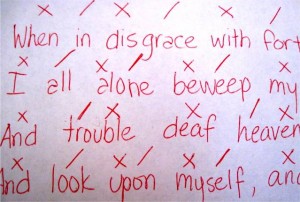“Just say the words:” subtext in Shakespeare
August 25, 2012 § 2 Comments
This startling statement is one of the first dramaturgical corrections I ever received about early modern performance, and one that I have heard often since. It is also one that infuriates my acting colleagues, appalled at the instruction to “just say the words.” Some time ago, on a forum with both literary and theatrical scholars as members, I attempted to explain why both sides of this debate were partially correct, and what each side was trying to communicate. Requests for this short piece of “translation” have continued to pop up over the years from people who remembered reading it but could not find it again. For those intrigued by the subject, here it is again in slightly modified form:
Shakespeare and Subtext
Theories of subtext date from the Russian schools of acting at the turn of the century, especially relating to training about how to perform Chekhov. Scattered throughout his major plays are scenes where the text (i.e.,. the dialogue) is at odds with other non-verbal (i.e.,. subtextual) aspects of the scene. A simple example might be the scene near the end of Three Sisters where Tusenbach holds a very trivial conversation with his fiancé Irina about coffee and a few items on his desk. The scene is utterly incomprehensible if you don’t know that Tusenbach is on his way to fight a duel that he suspects (correctly, as it turns out) he will not survive. This fact is never mentioned in the scene, and no reference is ever made to the reason that Tusenbach utters such banalities instead of telling his love goodbye, perhaps forever. We are left to conclude from his behavior and manner of delivery that his words have very little to do with the main plot interest at that moment. Commonly, we read into his psychology that he is unwilling or unable to utter the words out loud because he is unable to face his coming death.
As an acting teacher I have to help students learn to do something rather sophisticated and difficult when they face this kind of material, which is make the plot point clear by undercutting the dialogue and filling in with much “behavior.” To fail to do so in Chekhov is to render the play meaningless. In this usage, subtext doesn’t mean that the actor is feeling some parallel emotion or motivation for the speech. It doesn’t even mean that the actor is feeling something different than words are expressing. Characters do this throughout Shakespeare, as when Juliet pretends to agree with the Nurse about dumping the exiled Romeo in favor of Paris, or more subtly when Hermione delivers her moving trial speech in Winter’s Tale.
Sub-text (in the sense that it I am proposing, which is how it is used in actor training) means that there is an essential plot point in the scene that is not directly expressed or referenced in the dialogue. Audience members must infer this plot point by interpreting the non-verbal behaviors of the actors, even at times when their words explicitly contradict the underlying point. This dramatic technique is very common in Twentieth Century drama, and learning to play these behaviors is an essential acting skill.
The problem is that this skill has also proven useful in cases where there is no underlying plot point, but the text is minimal or banal (like, for example, much daytime soap opera writing for television). Some actors are now used to “filling in” with interesting bits of their own invention on almost all occasions.
The firm pronouncement that there is no subtext in Shakespeare pops up occasionally, almost always in connection with trying to put a stop to the indiscriminate use of this modernist acting technique in early-modern drama. “All you need to do,” actors are told, “is say the words.” To suggest that Shakespeare’s characters ALWAYS say exactly what they mean with no irony or sarcasm or intent to deceive is ludicrous. To suggest that actors do not need to feel and perform the inner lives of the characters is theatrically ignorant. It is sound advice to the inexperienced actor, however, to say the plot lines of the scenes are rarely, if ever, rendered totally below the level of dialogue in early modern drama. When the text is strong, invented subtext is unnecessary.
Shakespeare’s characters have inner lives, and occasionally they say something different from what we know they think. Playing both is important. The advice to avoid sub-text in pre-modern literature really just means, “don’t muck up the plot with invented stuff.”
Scansion for Beginners
August 22, 2012 § 4 Comments
There is a very funny video, “Stuff People at a Shakespeare Festival Say” going around, created by Great River Shakespeare Festival. Tabard jokes figure prominently in the beginning, but at around three minutes the scansion jokes pour forth. Of course I laughed, but it got me thinking again about how unfortunate it is that there are so few resources available to those really wanting to learn about scanning poetic meter and applying it on stage.

After many years of frustration at this situation while teaching classes on acting Shakespeare, I decided to take matters into my own hands and create a guide for my students – The Down and Dirty Guide to Scanning Verse. My friend, Edward Isser found room for it on a server at The College of the Holy Cross as part of a teacher’s guide for a larger project, for which I am very grateful. These days it gets a lot of hits because the Internet Public Library (http://www.ipl.org/) provided a link from its Shakespeare resources.
Because the basic rules are simple and easy to master, I thought I’d repost a link here also, to encourage the curious to give it a go. Happy scanning!